|
|
Search for
The Famous Blonger Bros. |
|

September 2006
| 9/2/2006 |
Good news around the corner. Wait for it...
|
| 9/6/2006 |
Ta Da!
How do you like our new look? I like it.
But there's more. Wait for it...
-CJ

|
| 9/7/2006 |

Welcome to the Blonger Bros. Emporium, fulfilling all your Blonger Bros. needs since 2006.
This year's special is the handsome and entertaining Blonger Bros. 2007 Wall Calendar. Twelve months of chuckles and chicanery!
It's 8.5 x 11, full color, spiral bound.
They won't be shipping until after Sept. 20th, but I just couldn't resist putting them up for pre-orders.
|
| 9/15/2006 |
You Meet the Nicest People
...at B&B's. In Phillipsburg, Montana, we met Marty and Pam Carrick, who took these photos of Marvin Blonger's grave in Dunsmuir, California. Marvin died there a few years after leaving Phillipsburg to live with his daughter, Ollie Buick. We have no other reason to visit California (other than the beautiful scenery), so we are grateful to Marty and Pam for taking the time to make a cemetery visit and send the photos to us.
-SJ
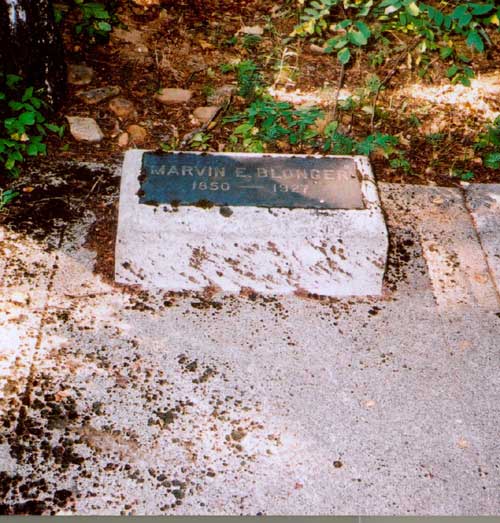
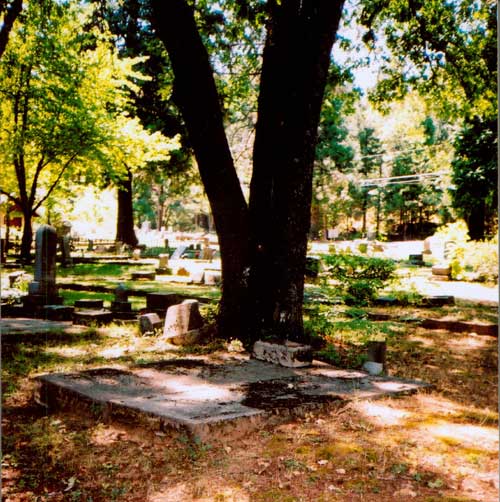
|
| 9/16/2006 |
The Joints
Scott found a new reference to a Blonger gambling house, a rarity:
Boulder Daily Camera, Sept. 26, 1891
Closed by the Police.
DENVER, Sept. 25.—The police board to-day ordered the gambling house of Blonger Bros., 1744 Larimer street, closed. The place is said to be a bunco joint, and the board wishes it understood it is after that sort of thing.
So let's take this opportunity to run down the known references to Blonger Bros. places of business in Denver:
1881: First police blotter entries, probably regarding a saloon or gambling house, are said to appear, prior to their stint in Albuquerque.
Sam and Lou are in Albuquerque from late 1881 to early 1883, probably.
Lou claims in his 1887 military pension form that he has resided in southern New Mexico since 1883.
Mid-1880s: Lou's obituaries say Lou and Sam's first Denver saloon was at 1644 Larimer Street in the Croff and Collins Building, which was next to the Cheesman Block on 17th. This saloon would have been behind, and perhaps even directly in back of, the Silver Dollar Saloon.
1891: Blonger Bros. gambling house at 1744 Larimer closed for bunko games.
1892: Blonger Bros. gambling house at 1744 Larimer closed for bunko games.
1892: "Blonger boys" arrested for facilitating a swindle in their Tourists Club, 1740 Larimer Street. Could this be the same joint?
1892: Blonger Bros. open a saloon on Market between Sixteenth and Seventeenth.
1893: Blonger Bros. club rooms, 1744 Larimer.
1895: Blonger Bros, mining office/Sam Blonger, saloon, 1644 Larimer.
1895: The Smith brothers come looking for the Blongers at "Lew Blonger's place," 1644 Larimer.
1896: Blonger Bros, mining office/Sam Blonger, saloon, 1644 Larimer.
1896: Sam Blonger, The Elite?, 1626 Stout.
1921: Lou's office, American National Bank Bldg, 17th & Lawrence
1921: Bunko gang lookout post, Rolnick Bldg., 17th & Curtis.
1921: Bunko gang fake stock exchange/betting parlor, The Denham Bldg., corner of 18th & California (not sure which corner).
-CJ
|
| 9/19/2006 |
Red Gallagher
Soapy tells us that the man who bailed Lou out upon his arrest in 1922, a Denver sport named R. "Red" Gallagher, was in fact an associate of Soapy Smith's in Skagway.
Rocky Mountain News, August 26, 1922
A few minutes later Blonger was a free man. His bond was given by Mr. R. ("Red") Gallagher, well known in Denver sport circles. Altho he had been incarcerated less than eighteen hours, he came out of jail a different man from when he entered soon after midnight yesterday morning. His health which, according to his wife, has been failing rapidly in recent months, appeared to have withered under his close confinement. He was pale and jaded.
He's a natural for the Grafters Club. Soapy — know anything more?
-CJ
|
| 9/17/2006 |
President Hornung
Congratulations to friend and colleague Chuck Hornung on his election as president of the Western Outlaw Lawman History Association. Godspeed, Chuck.
|
| 9/20/2006 |
The Soap Gang Returns?
Well, now. Our newspaper article calls him R. "Red" Gallagher, though of course they could have easily been wrong.
Mead was 45 in 1922. I think, actually, that Foster was an alias and Mead was his name, though he is listed otherwise on our Trial Cast page. He's actually a pivotal figure in the bunko trade — he is said to have introduced a concept that proved invaluable in the development of the big con, the so-called Magic Wallet — a "lost" wallet containing things that suggest the financial savvy of the owner.
Very interesting. I'd like to know why Mr. "Foster" had to leave town.
-CJ
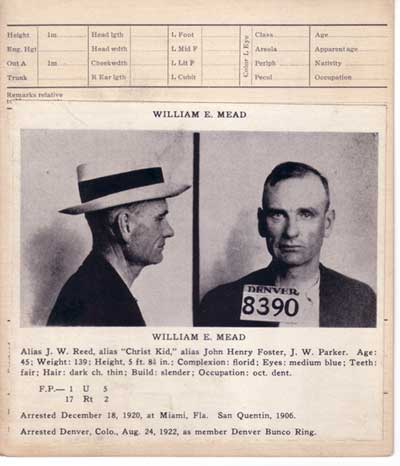
|
| 9/20/2006 |
The Soap Gang Returns?
We'll have to check out the scrapbook. And it wouldn't surprise me a bit if Foster is our man.
-CJ
High Sierra
Meanwhile Scott has turned up a Lou reference in a book review, on the novel High Sierra, which became a movie starring Humphrey Bogart and Ida Lupino. A heist story, natch.
[Author] Burnett also plays with the omniscient 3rd person view, changing point-of-view character faster than some folks change their socks. It lets us see the world from many eyes, not always in harmony. Even the dog's POV helps illuminate the situation. Burnett also loves name-dropping, both of the famous (John Dillinger) and the forgotten (Lou Blonger, the king of the Denver underworld).
We'll find the book and the movie.
-CJ
|
| 9/24/2006 |
Sam's Wagon Train
Name and Residence: S. H. Blonger, Minnesota
Number of Wagons: 7
Number of Persons: 17
Number of Stock: 129
Destination: California
Good hunting, Scott! He gets a free Blonger Bros. 2007 Wall Calendar.
Of Sam's trip West, we know only what his obituary told us:
He left Hastings in 1858 with an ox team and crossed the plains and mountains to Sacramento, Cal. In 1860 and 1861 he was engaged in "freighting" and in driving a stage coach over the mountains between Sacramento and Austin, Nev.
That he left from Minnesota always appeared to be wrong; not so. Freighting to Austin seemed more likely in 1862, when the boom there was underway.
And this from the Armstrong account:
Sam Belonger, when a boy of 18, walked barefoot with a wagon train across the ground where Denver, Colorado now stands. There were only two cabins then. At one time, about six miles east of where Denver's capitol-building now stands, Sam Belonger and Buffalo Bill Cody, while on a scouting trip, were chased and surrounded by a war party of eight Indians. Their only chance to survive the fight was to shoot their horses and use the bodies for breastworks. Both Uncle Sam and Buffalo Bill, being dead shots with rifles, killed all eight Indians and escaped.
That his wagon train might have gone through Denver also seemed suspect — this was not the route to California. That he should have met a thirteen-year-old Bill Cody there seemed even more of a stretch. Cody was only there briefly, to try his hand at prospecting, but he soon became discouraged and returned to the plains.
The two things we did know: that he voted in Colorado in 1861, and that he took title to a piece of land in California in 1865.
So what do we know now?
The listing above comes from a book now available through Amazon, Additional estimate for Fort Kearney, South Pass, and Honey Lake wagon road. Letter from the acting Secretary of the Interior, transmitting a communication from Colonel Lander in Regard to the Fort Kearney, South Pass, and Honey Lake wagon road.
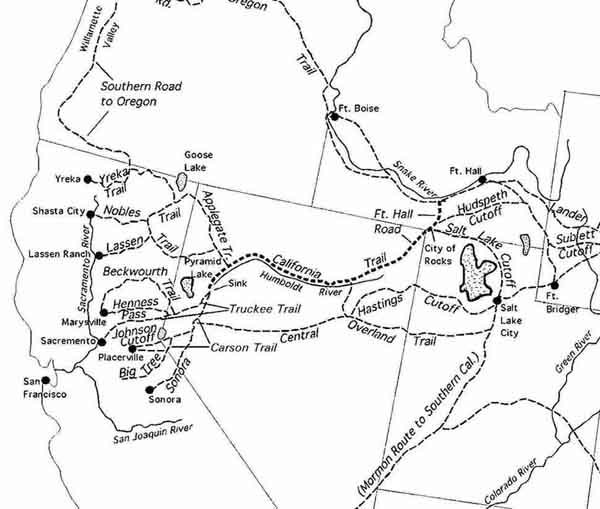
This report to Congress deals more largely with the expedition headed by Col. Lander to inspect and improve the California Trail, and details his mission, which was largely uneventful and an unqualified success. Open his return, he made a great effort to recommend his route to emigrants as rich in food, water and wood, largely safe from Indian attack, and free from the toll bridges sometimes erected by fur traders in the mountains. Specifically, the document contains a petition signed by some nine hundred men who had taken the route with Lander, indicating their agreement that a bridge should be built by the government over the Green River in Wyoming, to make the crossing safer for emigrants. They had lost one life, and some property, at this ford.
Sam, apparently, was a party to the petition.
Thirteen thousand emigrants travelled the road the present year; over nine thousand - all the males of the trains - signed papers of which the following are copies:
"We, the undersigned, emigrants to California and Oregon, having just passed with our wagons and stock over the new government road, from the South Pass to Fort Hall, (called Lander's cut-off,) do hereby state that the road is abundantly furnished with good grass, water, and fuel; there is no alkali and no desert as upon the old road, and while upon it our stock improved and rapidly recovered from sickness and lameness. We were much surprised at the great amount of labor that had been done in cutting out the timber and bridging and grading the road, and in all respect it more than met our expectations, especially those of us who have heretofore travelled the other routes. But we would most respectfully suggest that a bridge should be erected, as soon as possible, over Green river, the fording of which is dangerous and the cause of much trouble to the emigration, and in one instance the loss of life. We have been treated kindly, and in every case when the circumstances required it aided and assisted on our way by the Wagon Road Expedition; and we have likewise recieved (sic) the kindest treatment from the Indians; and we advise the overland emigration to California and Oregon to take this road as the shortest and best adapted for the comforts of the traveller and the preservation of stock, especially if the government, in view of the many advantage: of this route, should cause Green river to be bridged."
Signed by Ferguson Chappell and over nine thousand others.
Assuming Sam is an actual signer of the petition, it appears he was with Lander's party on this road, or at least among the thousands who made the trip that summer over the newly improved trail. Sam was still eighteen in the early months of 1858. Perhaps he left Minnesota at that time, but did not journey West from St. Louis until 1859. Lander states:
In that [report] of 1859 I related the fact of my stationing a party of men at that [Green] river, equipped with ropes and excellent mule teams, by the aid of which the emigrants crossed it without much difficulty, although some property was lost by them and one indivudual drowned. At that time the emigrants drew up two petitions asking that this river might be bridged, which, bearing several thousand signatures, in fact, the names of all the male individuals of their trains, were brought by me to Washington and referred to your department.
It is our assumption that Sam's inclusion in this document indicates he signed the petition.
The Lander expedition of 1859 is not well known today, undoubtedly because of its modest success, and lack of tragedy. It is remembered instead for the numerous artworks produced during the trip.
ON July 3, 1859, members of the artists, mess awake near Grass Springs in Nebraska Territory. Their covered wagon part of Colonel Frederick Lander's road-building expedition, had halted just east of the Green River, within sight of the Wind River Mountains. Nearby, a crowd of nearly three hundred emigrants shared the same dry piece of sage plain. At least three landscape painters in what Lander called his "full corps of artists" were about to record one of the largest July Fourth celebrations on the plains, augmented by Chief Washakie and eight hundred Shoshone Indians, who would set up in time to share speeches, fireworks, and gifts on this Independence Day eve.
By nightfall, one of the artists noted, "the chief appeared in a United States uniforms, which was presented him by Col. L., and the gaudy costumes of the rest as they danced to the sound of the 'rum-tum,' a sort of tambourine, all together was a magnificent sight to us. At dark we sent up a few sky-rockets, which terrified the Indians so that some of them ran away. They evidently thought we were a great people to send fire up so high."
Here's a beauty by Albert Bierstadt:

The route developed by Lander, called the Lander road or Lander Cutoff, went farther north in Wyoming and Idaho than other routes, avoiding the alkili deserts endured by those traveling to the south. It took longer than other routes, but it was well suited to wagon trains, with their voracious apetities for grass, water and wood.
If indeed Sam traveled this route, he would have started through Iowa, or Missouri, at Independence or St. Joseph, through Ft. Kearney, Nebraska, through Laramie, Wyoming, and South Pass, to Ft. Hall, Idaho, then down along the Humboldt river in Nevada, to Honey Lake, California and finally Sacramento. He may have had call to assist in the development of the road, which was graded in places, bridges built in others. He may have scouted.
Here's Honey Lake today, the western terminus of Lander's responsibility. It's very shallow, I hear, and dries up now and then.
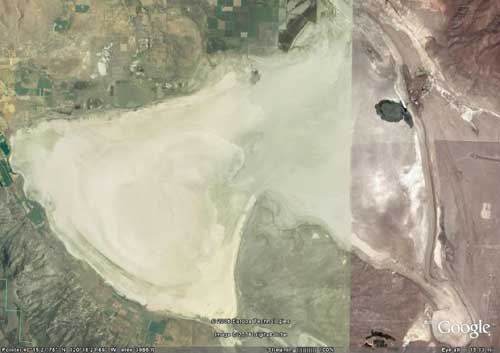
So did he detour to Colorado, and Denver City, to try his luck, then moving on to Sacramento and Virginia City in 1862 — or go all the way to California, with his group, as it seems? Did he then soon track back to Dnver for a time — then back to Sacramento again?
-CJ
|
| 9/25/2006 |
The Soap Gang Returns?
That'd be this guy here:

|
| 9/26/2006 |
About Time
Scott found a few more links, including a Nov. 8, 1937 article in Time magazine that mentions Lou, sort of:
When professional thieves are arrested, they rely first on the police ("in hard times a dollar or two or even a drink may be enough"). More difficult arrangements are handled by a fixer who works through the complaining witness, the prosecutor (by trading cases), the bailiff (who forges vacating orders), or the judge. So efficient are fixers that Denver's Ed Blonger for many years kept all his clients out of jail. Chicago's celebrated pickpocket, Eddie Jackson, was arrested "thousands of times," convicted only four times, twice because of factional fights between his political friends.
In books at Amazon.com, their Search Inside the Book feature turns up a new title or two with references.
Infamous Chicago grifter "Yellow Kid" Weil says, in his book Conman : A Master Swindler's Own Story:
...I knew a man named John Blonger in Denver. He owned some mining property he called the Copper Queen. The Copper Queen Mining Company had been incorporated by Blonger for $10,000,000. The company was authorized to issue a million shares of stock with a face value of ten dollars per share.
As far as I know it was purely a stock-selling scheme. I don't believe there was any attempt to mine the property, although Blonger did own some property. In those days all you needed to form a corporation was an excuse, an attorney, and $100.
We made a deal with Old John, as we called him, to put large blocks of his stock at one cent per share. We acquired 100,000 shares. There was no law to prevent us from selling it for whatever price we could get.
Back in Chicago, Weil and two accomplices set up shop as stock brokers, touting real stocks, and occasionally trading in them, but the idea, of course, was to push Copper Queen stock.
What to make of this? The Copper Queen? Old John? One assumes he must mean Lou. He must.
If you have been following our story, you know by now that, if it's a Blonger, it's one of our Blongers. There was Simon, Sam, Mike, Joe, Lou, Marvin. Marvin, whose middle name was Edward, had a son Ed. Simon had a son named Fred. Sam had Frank. Back in Wisconsin Mike had John. It would be a real stretch for either Ed or John to be connected with this kind of shenanigans.
Still, Old John? The book was published in 1948, so it had been a few years. His memory surely failed him.
In Gangland by Barry Albin-Dyer and James Morton, we hear that the Gondorffs, Fred, Charley and George took up the Big Store about 1900, and mentions that "master fraudsman" Lou had done the same in Denver, "the home of this particular confidence trick."
This also gives me cause to point out that three volumes — Bat Masterson: The Man and the Legend by Robert K. Dearment, Masterson by Richard S. Wheeler and Luke Short: A Biography by Wayne Short — all place Sam and Lou in Dodge in 1878, but we have yet to find the evidence.
-CJ
|
| 9/28/2006 |
The Grafters Club
My turn. Turned this up on Colorado's Historic Newspaper Collection:
Castle Rock Journal, Dec. 14, 1906
Alderman Frank P. Lennon, Republican candidate for sheriff of Pueblo county last fall, includes the following list of election expense items: "Paid the Grafters Club $100; for churches, grab bags, lotteries, etc., $46.50 for workers who worked, $60; for workers who didn't work, $80; two jugs of 'good cheer' that made the recipients so cheerful that they forgot to vote, $8."
I guess Col. Van Cise wasn't lying when he said it was one of Lou's favorite Denver joints.
-CJ
|
| 9/29/2006 |
High Sierra
Got a copy of High Sierra today. Not sure if I'll read it. I did find the Lou reference, though. It's a crime novel, by the author of Little Caesar, W.R. Burnett. It became a classic Bogart movie, though I haven't seen it, yet.
Humphrey Bogart stars as Roy "Mad Dog" Earle in this 1941 classic. Pardoned after a lengthy stint in prison, Roy looks forward to savoring his newfound freedom. No such luck! It seems his release was brokered by a crime lord who wants to recruit him for a heist. Plus, Roy and his partners in the caper, who were all handpicked for him, are angling for one woman's affections: a dancer played by the ravishing Ida Lupino.
Given the storyline, there is talk of fixers and their trade. On page 182, Earle says to Ida, I mean Marie:
Take my pal, Barmy. He was the smartest there was. Used to be rolling in dough. But he got old and they caught up with him. Like we all get caught up with some day. He worked with Blonger, the Big Guy, in the old days, and he used to make sometimes as high as two hundred G's a winter in Florida. In the summer he worked Denver, where the fix was perfect.
Bogart, I mean Earle, dies in a shootout on a mountain highway.
Next: NetFlix
-CJ
|
September 2006
|
Genealogy - History - Gang - Posse - Evening Review
The Grafters Club - Blonger Bros. Fake Restaurant
|
Copyright Notice: Original material copyright 2003-2021 Scott Johnson and Craig Johnson. Other copyrights may apply to materials found herein. Our primary goal is to reintroduce the Blonger Bros. to the lexicon of the Wild West. We therefore encourage the use of our research, provided due credit is given.
https://www.blongerbros.com
|
|



